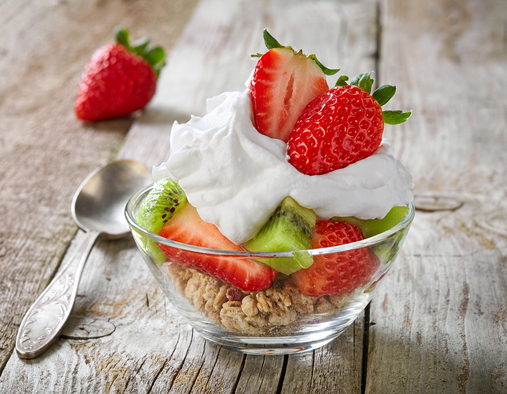
Got a skinny kid? If so, then you know that underweight children are often overlooked in a society where obesity is considered an American epidemic. Story after story appears on the media about the dangers of overeating, but very little coverage is given to the troubles of chronically underweight children. Parents of Slim Jims are often caught between the pressure of providing a healthy diet and the instinct to take whatever shortcuts are necessary to “fatten him up.”
For picky eaters, or unusually active children, adding cakes, cookies, and ice cream to a child’s diet is a terrible solution that can only lead to future bad habits and health issues. Yet the instinct to add calories to a “Skinny Minnie’s” diet is smart, if it’s done in a mindful and healthy way. Before you prepare your next meal, consider the following high-calorie, highly-nutritious meal and snack ideas.
For all you dieting parents, prepare to drool.
Awe-Inspiring Omelets
Eggs are nature’s perfect protein. They can be served hard-boiled, soft-boiled, poached, scrambled, sunny-side up, and in a dozen other ways. They’re a good source of B and D vitamins as well as minerals like zinc, selenium, copper and iron. Made into omelets, eggs can enfold a lot of additional nutrient magic: Proteins like cheese, ham, or slices of steak as well as vegetables like mushrooms, peppers, onions, chopped tomatoes, or even high-potassium avocados. Make breakfast an explosion of color, taste, texture, and good old-fashioned protein. Serve with sliced potatoes browned in butter to up the morning quota of carbs and fats.
Banana And Almond-Butter Sandwich On A Whole-Wheat Roll
If your child lives on PB&J, consider this healthy, calorie-rich alternative. Almond butter is a superfood because of its heart-healthy fat content. Bananas add sweetness, calories, and mineral content, while a whole wheat roll adds complex carbohydrates.
As a side, consider tossing a baggie of cubed cheeses into the lunch box. Cheese is condensed milk protein that comes in a million flavors for even the pickiest eater: Consider spreading creamy brie or mild goat cheese on whole wheat crackers, or slicing slivers of mild Gruyere or tangy Parmesan. Messier alternatives include balls of fresh mozzarella, a cup of creamy cottage cheese, or even fresh ricotta.
Hummus And Turkey On Whole-Grain Flatbread
A kicked-up version of the baloney sandwich, this wrap marries the vegetable protein of chickpeas with the lean protein of an utterly inoffensive deli staple. If your child permits, add tomato slivers for tartness or a sprinkle of shaved carrots for color and crunch.
Sweet Potato Corn Chowder
Rethink lunch, the afternoon snack, or even dinner with this delicious variation on old-fashioned chowder. Cream-based soups provide milk protein and have immense versatility. This soup recipe takes advantage of a carb-rich root vegetable and can be modified by adding beans or even chunks of chicken. Warm, filling, savory, and delicious.
Perfect Yogurt Parfait
You probably buy low-fat yogurt by instinct, but avoid the low-fat designation for this eye-catching mid-afternoon snack. Layer thick, creamy yogurt with sliced bananas, honey-rolled oats, and chopped dried fruit. The yogurt provides the milk proteins while the dried fruit infuses dense calories and minerals. Children without nut allergies can also add chopped almonds, walnuts, or hazelnuts. A powerful and practically perfect treat.
Berries And Freshly-Whipped Cream
Fresh whipped cream, made at home with a teaspoon of vanilla and no more than a dash of honey, takes less than five minutes to make. Served with either fresh berries or slices of dried mango, papaya, pineapple, or other fruits, this snack offers sweetness without empty calories, as well as plenty of fat, vitamins and minerals.
Whole Wheat Fettuccine Carbonara With Peas
An active child needs carbohydrates. Carb-loading is a way to build up energy reserves, so it’s a good idea to arrange a meal around whole wheat pasta, long grain rice, and other starchy foods. This particular dish also adds protein in the form of a delectable cream sauce made with eggs and cheese. A legume like peas adds color, vegetable protein, and essential vitamins and minerals. You could modify the recipe by tossing in some chopped chicken to ante up the calorie and protein count as well.
Baked Potato Topped With Temptation
This one-dish meal can be crafted to suit your picky eater’s preferences. Smothering the potato in butter, sour cream, and freshly shaved Parmesan cheese adds milk protein, vitamin D, and calcium. Chop in some broccoli florets for color, but only if it doesn’t make your child turn up his nose.
Almond-Crusted Tilapia
Not all kids will eat fish, but thin, mild-fleshed fish like tilapia is full of omega-3 fatty acids. When dredged in a chopped-almond-coating, pan-fried in olive oil, and then topped with slivered almonds browned in butter, you’ll create a delicious almond-crusted fish full of heart-healthy and brain-building nutrients. Try serving it with root vegetables like parsnips, turnips, and butternut squash, which are high in complex carbohydrates. Drizzled with olive oil and roasted, these colorful vegetables will add sweetness to the meal.
Bring Back Dessert
Banish sugary-sweet, empty-calorie cookies, ice cream, or cakes in favor of good old-fashioned, reasonably-sized servings of custards, tapioca, and rice puddings made with whole milk. Whole milk packs a wallop in calories and is a healthy part of an underweight child’s diet, as long as drinking multiple glasses doesn’t interfere with other food intake. Other examples of good desserts to consider might be a slice of a pecan-topped sweet potato pie.
Set The Table
Whipping up a nutritious, high-calorie meal is only the first step in nudging your child to fill his energy needs. Make meals family events, whenever possible, and keep the dinner table a distraction-free zone to encourage your ball of energy to finish eating before zooming off to other pursuits. Take advantage of psychological tricks by making the meal look smaller by putting it on a bigger plate, or, conversely, piling lots of food on a smaller plate, whatever works for your own child’s particular quirks. Feeding smaller meals more frequently may also improve overall daily calorie intake.
Rest assured that a child is only considered medically underweight if 95% of children in his age and height bracket are heavier than he is. Once digestive, thyroid, or eating disorders are ruled out, the cause is usually attributable to genetics, as a child will likely develop the same body shape and size as his parents. But if genetics doesn’t appear to be the cause, and your efforts don’t appear to be nudging your child into proper growth, never hesitate to discuss your concerns with your pediatrician.






